Page 1 Daily News
by Gail Helmer
Friday, April 27, 2001
PC News
New B-17 2 Patch 2
COMBATSIM has learned that Wayward Design has completed a new B-17 2 Patch 2. Bombs-Away.net has received the patch and is expecting to have it ready for download on Saturday April 27th. The new patch is 25.3mb and the major difference is to be found in the way the simulation manages engines. Simulation and Modelling of the engines has been made more complex and realistic. Click here to download the read me file.
Flanker Beta 5 V2.51 Released
SSI has announced that Beta 5 of V2.51 is now available for downloading. The file is a about 1.5 MB in size.This Beta 5 is being considered as a candidate for the release version of 2.51. Unless there is a major problem introduced by Beta 5, this will be the final beta release for v2.51. Please remember that this is a Beta and may have problems. Click here for download links and read me files.
WarBirds Memorial Weekend Shoot-Out
WarBirds is offering three of the WarBirds Arenas to FREE access Memorial weekend, May 25th to 28th, 2001. The Main arena will offer a range of aircraft, changing as the weekend progresses. Can you do well in the early World War II aircraft, as well as later? For those with an interest in reenacting scenarios from the war, try out the Historical and Special Events arenas.
Click here for more details.
No G800 From Matrox
Anandtech.com is reporting that Matrox will not be releasing the G800. "Matrox is continuing their stance that they will re-enter the gaming market at one point, but don t expect that to be with their next card. Matrox won t be focusing on the gaming market anytime in the near future."
COMBATSIM contacted Matrox and was told by a Press Agent that, "Matrox has a full product line up set to be coming out during the course of this year. You certainly haven't heard the last from Matrox"
Echelon Goes Gold
Bethesda has announced that Echelon has gone gold and should be in retail stores throughout the U.S. during the first half of next month. Echelon is a futuristic aerial combat game that puts users in battle over alien landscapes and towering cities as a member of an elite fighting force facing a revolution on a colonial outpost. Featuring branching campaigns, a broad range of airliners, and three unique aviation models, Echelon features controls that can be tailored to offer a simulation or an arcade experience. Hardware accelerated 3D graphics allow for dust and particle effects, realistic water, and detailed landscapes and building models. Support is also included for deathmatch and team competition across a local area connection or the Internet.
Military News
New European Missile Conglomerate Takes On Raytheon
EADS, BAE SYSTEMS, and Finmeccanica have finally signed a deal to create a missile production big enough to take on the world' number one, Raytheon. Signed yesterday and announced this morning, the deal brings together the EADS and BAE SYSTEMS joint venture, Matra BAe Dynamics and Finmeccanica's Alenia missile unit in a new company to be called MBDA.
EADS and BAE Systems each hold 37.5% stakes of the enlarged company with Finmeccanica holding the remaining 25%. The new company will have sales of 2.5bn euros (£1.6bn) an order book of around 13 billion euros.
The new missile group, to be called Matra BAE Dynamics Alenia or MBDA, will rank behind the US missile giant Raytheon and ahead of Lockheed Martin and Boeing.
EADS and BAE Systems will each own 37.5 percent stakes in the missile company, with Finmeccanica holding the remaining 25 percent.
"The consolidation process of the European missile systems industry to ensure its durability against fierce competition from an already re-structured US industry is now taking a new and decisive step forward," EADS chief executives Philippe Camus and Rainer Hertrich said in a statement.
Fabrice Bregier, currently CEO of Matra BAe Dynamics, has been appointed chief executive of MBDA.
Because the new company is considered essential to protect the national security interests, a category exempt from European Commission merger oversight, the British, French and Italian governments said they would not notify the proposed MBDA venture to the EU.
Products for the new company include the Meteor air-to-air missile selected by the RAF for its Eurofighter, against strong competition from Raytheon's BVAAMRAM, the SCALP and Storm Shadow cruise missiles and the PAAMS surface-to-air naval missile that will be fitted to UK, French and Italian frigates..
As part of the deal, BAE SYSTEMS said it would place its land an naval radar business in AleniaMarconi Systems, its 50/50 joint venture with Finmeccanica, while the missile component of the JV would be placed in MBDA. Finmeccanica is expected to add moere to AleniaMarconi to maintain its 50% share.
Global Hawk's First Australian Mission
The United States' unmanned aerial vehicle (UAV), Global Hawk, that arrived in Australia after the first trans-Pacific flight by an unmanned aircraft on Monday, has embarked on its first mission over Australia.
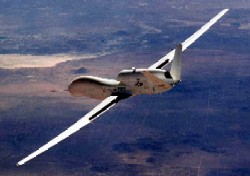
Global Hawk took off from RAAF Base Edinburgh yesterday for a 24-hour mission that will cover a wide area of central and southern South Australia. The mission was originally planned to take place yesterday but was delayed by strong and gusty cross winds at RAAF Base Edinburgh.
During the mission the Global Hawk deployment team will perform a systems shakedown and characterisation as well as provide valuable training for mission operators monitoring Global Hawk's flight on the pre-programmed, computerised route over South Australia.
"This mission is an important first step in demonstrating the capabilities of Global Hawk and accomplishing the training crew coordination for the rest of the Australian deployment," said Global Hawk Programme Director, Col Wayne Johnson of the United States Air Force.
Over the next six weeks Global Hawk will fly 11 missions over northern and eastern Australia as part of the joint military exercise Tandem Thrust.
Future Of Airborne Anti-Submarine Warfare
According to Forecast International's new study, "The Market for Airborne ASW Sensors." ASW sensors used aboard aircraft will generate nearly $5 billion in sales over the next 10 years. The study, which provides a 10-year overview analysis sampling of the airborne segment of the military ASW sensors market, predicts that aircraft will remain the submarine's most dangerous enemy.
Ship-based helicopters continue to be one of the most useful and flexible of ASW platforms, especially in terms of their multimission nature and ability to move out ahead of their host ship, thereby extending the range of the defensive zone. The United States and NATO are expected to continue adding new ASW capabilities to existing helicopter fleets, and to field new ASW helicopters in the near future.
Land-based, fixed-wing, maritime patrol aircraft, such as the P-3C Orion and Nimrod, will remain in service through the forecast period, though major upgrades may be put off as the services contend with additional funding reductions, ageing airframes and the changing threat. Avionics will remain a principal force in ASW, as ever more sophisticated processing equipment allows for the detection of even the smallest whisper travelling through the seas.
Faced with the high technical standards of a new generation of submarines now making their way into active service, navies are resorting to integrating systems so that the limitations of one are offset by the merits of another. In the US this is being developed under the rubric of "Netcentric warfare" a concept where all information from all platforms is assembled into a single tactical picture.
The result is indeed a revolution in how to fight. For example, a P-3 Orion could be coached to a location by a combination of satellite imagery and ground-based communications intercept and then locate the submarine using passive sonobuoys and MAD. This contact could then be attacked using precision guided bombs delivered by strike aircraft. Done properly, the submarine would never realise the danger until the bombs exploded around it. The danger is that the possibilities of netcentric warfare are so mesmerising that the sharing and networking of information becomes an end in itself rather than a means to attain the end of delivering explosives to a target.
Another factor, according to Forecast International, impacting the ASW airborne sensors market is the extent to which corporate amalgamations and market withdrawals are decreasing the number of significant players. In Europe, the interlocking network of company ownerships, joint ventures and mutual shareholdings means that the companies, for all their appearance of independence, are actually already closely integrated. The US multi-contractor category actually represents consortia of the major US companies, working together in teams assembled for specific programmes; a different form of integration perhaps, but equally close and, apparently, no less effective.
Thursday, April 26, 2001
Strategy First To Publish Steel Beasts
Strategy First Inc. and eSim Games announced today that they have signed a worldwide retail publishing agreement for Steel Beasts, making it the first time that the game will be available in retail stores.
"Strategy First is thrilled to be bringing this terrific title to market," says Steve Wall, V.P., Business Development. "We felt it was a shame that the majority of consumers couldn't get their hands on this excellent game, so we did something about it!"
"eSim Games is very happy with the partnership, " says Al Delaney, owner of eSim Games. “We’ve known Strategy First for quite some time, and I think this is a good fit. We’re also excited about making Steel Beasts more easily accessible, and more widely known.”
Steel Beasts is a detailed PC-based simulator of modern mechanized warfare, centered around two of the world’s most awesome main battle tanks: the US’s M1A1 Abrams, and Germany’s Leopard 2A4. Players can experience all the sights and sounds of modern armored combat from the gunner’s or tank commander’s position, as well as the challenges of tactical planning and decision making from a powerful map view. In addition, multiplayer support allows any mission to be played over a network with any cooperative or competitive style of play, including multiple players in a single tank.
Scheduled for release in May 2001, Steel Beasts will be distributed throughout North America by Infogrames and in Europe by our other worldwide partners.
World at War Ships
Take-Two Interactive Software, Inc. , subsidiary, TalonSoft, Inc, today announced that "World at War" has shipped to retailers. World at War exemplifies tactical wargaming at its finest by bringing you the most comprehensive collection of TalonSoft's award winning Campaign series to date.
World at War combines West Front, East Front II, Rising Sun and all the official add-ons and expansion packs in one action packed experience. Also included is TalonSoft's Fall of the Reich, the official expansion pack for East Front II, never before available in stores.
This exclusive compilation boasts over 350 world-shattering scenarios of World War II history, through 27 linked campaigns. Expand the boundaries of the war in 20 dynamic hypothetical campaigns and command forces from over 20 different nationalities including Germany, Britain, America and Japan. World at War allows players to dictate the events of World War II from the tumultuous beginning to its climatic conclusion.
The Campaigns Series includes extensive map and scenario editors creating an endless supply of new and exciting settings and conflicts. In addition World at War offers multiplayer support for up to 16 players via LAN or over the Internet including Head to Head play and Play by Email.
Sidewinder Game Voice 1.3 Beta Upgrade Released
Sidewinder's Game Voice continues to evolve with its latest 1.3 beta release. This is the most significant update to Game Voice since its launch last fall: Game Voice 1.3 improves the voice recognition performance of the device, bringing faster response when gamers issue voice commands, a press release announcing the beta upgrade said. For advanced users, a Game Voice Server application has been added, which helps gamers find other Game Voice users and allows larger chat sessions while saving bandwidth. Game Voice brings users out-of-the-box voice chat and supports vocalized game commands. A free limited-feature version can also be accessed. Game Voice is available for an estimated street price of 54.95 USD. Click here to download the beta.
Operation Flashpoint Update
Codemasters has injected its Operation Flashpoint website with a slew of new content for the 3D tactical shooter, including new unit information and screenshots. Click here to check out the website.
Military News
Clock Strikes 1,000-Hour Mark For F-22 Program
The F-22 Raptor program left its mark on aviation history April 18 as the program completed 1,000 hours of flight testing. Chuck Killberg, a Boeing project test pilot with the F-22 Combined Test Force, flew Raptor 4003 when the aircraft reached the 1,000-hour mark. The Raptor is the third production F-22 delivered to the CTF and the aircraft dedicated to expanding the flight envelope to F-22 operational requirements.
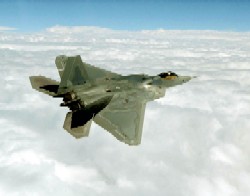
The mission continued flight testing the structural capability of the Raptor as part of the envelope expansion program.Through missions such as these and avionics test missions, the CTF hopes to provide the Air Force Operational Test and Evaluation Center with a weapon system that will be ready for the initial operational test and evaluation phase in December 2002.
"This significant achievement, and the many flight test hours to come, are a real indicator of just how thoroughly we are testing the Raptor -- a direct result of the hard work, dedication and professionalism of the integrated government and contractor team," said Col. Chris Seat, F-22 CTF director.
For the past several years, the CTF's flight test activity has centered on flight sciences, such as flying qualities, structures, utilities and systems, propulsion and performance. But by adding two of the planned six avionics flight test aircraft early this year, the F-22's avionics systems developmental testing will increase the pace of the CTF's flight test activity.
The third avionics test aircraft, Raptor 4006, is scheduled to arrive here later this month, while the remaining three test aircraft will arrive later in the year. (Photo by Judson Broehmer)
Ultra Electronics Wins Tomahawk Weapon Systems Contract
Ultra Electronics' Command and Control Systems Division has been awarded a three year contract by the UK Ministry of Defence (MoD) to provide system engineering support for the Tomahawk Land Attack Missile (TLAM) weapon system fitted in submarines.
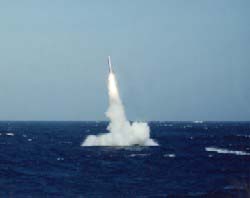
Ultra, the UK based aerospace and defence electronics group, was a key member of the Lockheed Martin team that developed and integrated the TLAM system for the Royal Navy. In addition, Ultra supplies the Weapon Interface Equipment in all Royal Navy submarines, which is at the heart of the UK TLAM weapon system. Ultra's work will involve analysis of the technical performance of the integrated system on the submarines and the provision of support services to investigate interface and documentation issues.
The Ministry of Defence, Defence Procurement Agency, TLAM Integrated Project Team (IPT) has overall responsibility for the programme. The original contract to procure the system for the Royal Navy submarines and associated shore facilities was let in 1996 and was one of the MoD's most successful procurement programmes, meeting all its milestones on time.
Switzerland's F-18 Upgrade 21 Programme
The Government of Switzerland has requested a possible upgrade of their Swiss Air Force (SAF) F/A-18 aircraft. The F/A-18 "Upgrade 21 Programme" consists of Fleet Retrofit Kits of the following systems:
34 AN/APX-111 Combined Interrogator Transponders,34 Tactical Aircraft Moving Map Capabilitys, 50 Multi-functional Information Distribution System/Low Volume Terminal (Airborne Link-16).
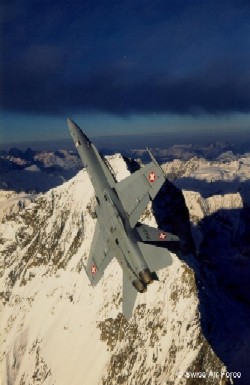
Switzerland has also asked for validation and verification kits of the following systems: Three Joint Helmet Mounted Cueing System, Three Enhanced Interface Blanker Units and Three Digital Communications to Wingtips.
The proposed programme support includes spare and repair parts, support and test equipment, publications and technical data, personnel training and equipment, US Government and contractor engineering and other related elements of logistics and programme management support. The estimated cost is $225 million.
The SAF intends to purchase the Upgrade 21 Programme equipment to enhance survivability, communications connectivity, and extend the useful life of its F-18 fighter aircraft.
The prime contractor will be Boeing Military Aircraft and Missile Systems of St. Louis, Missouri. There are no offset agreements proposed in connection with this potential sale.
Republic Of Korea Asks For MK 41 Vertical Launch Systems
The Republic of Korea has asked the US for a possible sale of three MK41 Vertical Launch Systems , with the necessary training, personnel and logistic support.
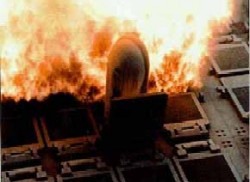
The missile launchers will be installed on new construction destroyers and are intended for use with Standard missiles as the principal air defence armament of these new vessels.
The estimated cost is $98 million. The principal contractors will be Lockheed Martin Marine systems of Middle River, Maryland and United Defense Limited Partnership of Minneapolis, Minnesota. One or more proposed offsets agreements might be related to this sale.
Korea has also asked for spare partsworth approximately $500 million under a Cooperative Logistics Supply Support Agreement (CLSSA) requisition case (FMSO II) for the support of F-4D/E, RF-4C, F-5A/B/E/F, RF-5A, A/T-37, T-38, F-16C/D, and C-130H aircraft; AN/FPS-117 and AN/FRN-45 radar systems; and AIM-7, AIM-9 and AIM-120 missile components.
Wednesday, April 25, 2001
PC News
Hidden & Dangerous 2 Announced
GodGames, a subsidiary of Take-Two Interactive Software, Inc., and game developer Illusion Softworks, today announced the development of Hidden & Dangerous 2, the highly anticipated sequel to the PC game Hidden & Dangerous. Hidden & Dangerous 2 will be released in this fall for the PC and distributed by Jack of All Games, another Take-Two subsidiary.
Players will be challenged by the game's unique blend of action, strategy and tactics in more than 20 complex missions over nine different campaigns. Virtual soldier's face of in locations throughout the world, from the lush jungles of Burma to the harsh deserts of Africa. And for a full-on frontal assault, Hidden & Dangerous 2 will feature multiplayer modes including Cooperative and Deathmatch play, with the option to play as Axis forces. A true-to-life combat zone is created through sophisticated motion capture animation, dynamic lighting and shadows, and highly realistic character movement and action. Players have a multitude of vehicle choices including trucks, tanks, motorcycles and planes.
Commanding unstoppable power, gamers will recruit and control the Special Operations Executive Section through the most perilous covert missions behind enemy lines during World War II. Each critical decision made affects the gamer's country and ultimately the success of the mission and survival of the team.
Hidden & Dangerous 2's Features include:
Hercules Announces The Gaming Zone
Hercules has announced a new addition to its web page, the all-new GAMING ZONE. This provocative new site will be created in partnership with GameSpy, using the powerful GameSpy Arcade to bring gamers the most intense online gaming experiences and thousands of new files to download.
This new Gaming Zone has a full line up of web-based games including DJ Nights, Dual Maze, Web Tennis, Rainbow Six, and Skating Zone. Ranging from sports games to arcade style games, users will be able to log on and compete for top scores and prizes against other Hercules' enthusiasts. This new GameSpy Arcade will also allow gamers to meet up and compete in some of their favorite CD-based games including Quake 3, Unreal Tournament, MidtownMadness, and Crimson Skies. Users can access gaming news as well as check out the latest deals at the Hercules Online Shop and keep up with the newest Hercules product releases. Click here to check out the Gaming Zone.
NVIDIA Game Spotlight Of The Week
Mark Randell and the team at Terminal Reality, Inc. unleashed the GeForce3 GPU to truly achieve nfiniteFXTM with 4x4 Evolution, an arcade style, 4x4 simulation game for the PC. By adding Pixel and Vertex Shaders to their LOD level terrain and 15 complex off-road environments, this title drips with detail! Textures take on a new feel and the intricacies of massive geometry inject a high level of fidelity into every single truck, shrub, oil derrick, plank of wood, and flying particle of dirt. Click here to check out the latest Game Spotlight with screenshots and videos.
Military News
Air Force Releases Base Impact Statement For F-22
The Air Force has filed the draft Environmental Impact Statement with the Environmental Protection Agency on the proposed home of the first operational wing of F-22 Raptor aircraft. The official notice of availability will be published in the Federal Register on April 27, beginning the 45-day public comment period on the draft EIS.
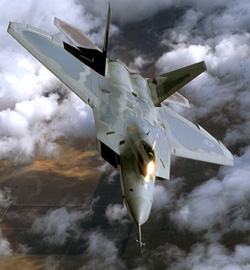
The Air Force has identified Langley Air Force Base, Va., as its preferred location, but four other bases are also being evaluated: Eglin and Tyndall AFBs, Fla.; Elmendorf AFB, Alaska; and Mountain Home AFB, Idaho.
The draft EIS is part of a two-year analysis process examining the potential environmental impact associated with basing the first operational F-22s. Among the resources analyzed are the natural environment (air, water and land) and the human environment (health and safety, cultural resources, transportation and noise).
The F-22 multimission air-superiority fighter is being developed to replace and supplement the aging F-15C Eagle. The proposal for the first F-22 wing includes 72 operational aircraft. The first aircraft is scheduled for delivery in 2004.
A series of public hearings in communities around the five bases and in the vicinity of the training airspace have been scheduled to gather public comment on the draft EIS. Feedback gathered from these meetings will help the Air Force create the final EIS.
Raytheon EW Equipment For Israeli Air
Raytheon Company has been awarded two contracts totaling $60.5 million to provide the Israeli Air Force F-16I New Fighter Aircraft fleet with equipment for use in the aircraft's electronic warfare suite. The contract awards were received from Elisra Electronics Systems, Ltd, the prime contractor for the F-16I electronic warfare suite. Both awards are part of the Israeli Peace Marble V Program, under which the Israeli Air Force is procuring F-16 Block 50 aircraft.
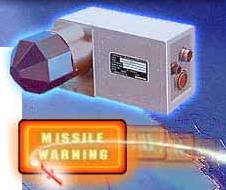
The first contract is for staring infrared sensors that support accurate and timely missile approach warning. The basic program includes development and production of 100 infrared sensors, with additional services and options. Raytheon's sensor features a staring, single color infrared focal plane array, an ultra-compact lens, and a sensor package that fits into a five-inch cube. The sensors are part of the missile warning system to be delivered by Elisra for the F-16I. All hardware and documentation deliveries are planned to complete by January 2004.
Raytheon's line of missile warning products includes the infrared airborne staring sensor, the AAR-58 scanning infrared system, and a directional infrared countermeasures system. Work on the infrared sensor contract will be performed by Raytheon's Electronic Warfare Operations and Infrared Operations, both located in Goleta, Calif.
The second contract award is for high power radio frequency amplifiers. The program includes development and production of 100 amplifiers, with additional funded spares and services. The period of performance extends through 2005. Raytheon's power amplifiers feature high power, rapid output port switching, and are common line replaceable units for the Israeli Air Force's F-16 fleet. The amplifiers are part of the electronic countermeasures system to be delivered by Elisra for the F-16I. The award includes options which may be exercised through 2005 for additional hardware sets.
Raytheon's experience producing power amplifiers stems from an earlier contract providing airborne missile jamming equipment to a NATO-member Air Force. Work on this contract will be performed by Raytheon's Electronic Warfare Operations.
General Dynamics Second Attempt At Newport News Shipbuilding
General Dynamics is having a second bite at Newport News Shipbuilding (NNS). After falling foul of US DoD objections at the last attempt in 1999, General Dynamics is offering to buy all of Newport News Shipbuilding's publicly held outstanding shares at a price of $67.50 per share, a bid worth $2.6 billion.
General Dynamics is hoping that the Bush Administration will feel more relaxed about the anti-trust implications of General Dynamics controlling all nuclear powered naval ship-building through NNS (aircraft carriers) and Electric Boat Company (submarines) than its Clinton predecessor, The Company is likely to have taken unofficial soundings, rather than face a second failure.
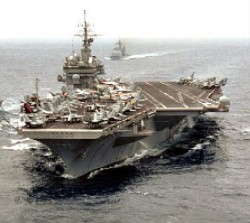
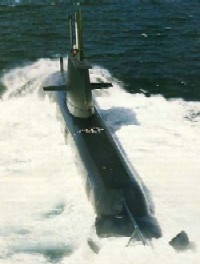
The move will concentrate all naval shipbuilding in two companies, Northrop Grumman having recently taken control of Litton, which shares non-nuclear ship building with General Dynamics' Bath Iron Works.
The acquisition, approved by the boards of directors of both companies, includes the assumption of approximately $500 million of Newport News Shipbuilding debt. The tender offer will begin within seven business days. The acquisition, subject to the tendering of a majority of the Newport News Shipbuilding shares as well as regulatory review, is expected to close in the third quarter of 2001.
Following the completion of the tender offer and necessary approvals, General Dynamics said it intends to consummate a second-step merger in which all of the remaining Newport News Shipbuilding shareholders receive the same price paid in the tender offer.
"Newport News is a solid, well-run company with sustainable revenues and earnings and strong cash flow. Our offer reflects its inherent worth, offers Newport News shareholders an attractive premium, and provides a wonderful opportunity to save significant amounts of money for the US Navy while retaining both nuclear shipyards, " said Nicholas D. Chabraja, General Dynamics chairman and CEO.
William P. Fricks, chairman and CEO of Newport News Shipbuilding, said, "This acquisition will provide Newport News shareholders an attractive price, and our employees will benefit from being part of a larger, more diverse company. It will enhance job security, and provide more career choices in a wider enterprise. Today, Newport News is the nation's sole supplier of aircraft carriers, and we're teamed with Electric Boat on the Navy's only new submarine program. Combining our companies will provide our customers with significant cost savings to support the nation's need to build more nuclear ships."
Newport News Shipbuilding, headquartered in Newport News, Virginia, designs and constructs nuclear-powered aircraft carriers and submarines for the US Navy and provides life-cycle services for ships in the Navy fleet. The company employs approximately 17,000 employees and had 2000 revenues of$2.07 billion, and net income of $90 million.
General Dynamics, headquartered in Falls Church, Virginia, employs approximately 46,000 people world-wide and anticipates 2001 sales of approximately $11.5 billion. The company has leading market positions in business aviation, information systems, shipbuilding and marine systems, and land and amphibious combat systems.
Korea 50 Years Ago This Week
A firm stance by U.N. forces in Korea stopped a Chinese and North Korean spring offensive, inflicting massive losses, 50 years ago this week. The defensive action kept Seoul from falling into communist hands for a third time since the war began.
April 26, 1951 -- Maj. Gen. Frank Milburn orders I Corps to withdraw from line Delta as the North Korean Peoples Army I Corps and XIX Army Group hit the Republic of Korea 1st Division's 11th Infantry Regiment on the west end of the line, and 3rd Infantry Division's 65th Infantry Regiment.
Milburn's plan is to establish another line between Delta and Golden, the second defense line above Seoul, set by Lt. Gen. Matthew Ridgway April 12. He sets a line centered on Uijongbu but just above the town.
I Corps' withdrawal sets off a chain reaction across the front, with IX and X Corps pulling back to keep their flanks protected.
To Lt. Gen. James Van Fleet, Eighth Army commander, there is evidence the enemy offensive is losing its punch. Information gained from captives reveals their commanders have no clear objectives and are themselves confused. Since the Chinese offensive began April 22, it's estimated that just in the I Corps sector alone, infantry, artillery and air strikes have killed 48,000 Chinese and North Korean Peoples' Army troops. That's the equivalent of five divisions.
With I Corps' withdrawal, Van Fleet establishes another defense line. It connects with line Golden in the west, then curves slightly down to just above where the Pukhan River joins the Han. Then it angles sharply northeast to the coast above Yangyang.
Van Fleet does not give a name to the line, so it becomes known as the No Name line.
It's understood that adjustments in the line will be based on the movements of I Corps.
That night, Chinese forces get past two companies of the 25th ID's 27th Infantry Regiment. Regimental reserves stop them after a mile. Then air attacks hit the enemy. A radar-guided bomb wipes out the enemy lead section. A flare, dropped by a plane, illuminates the enemy and GIs on both sides wipe out the rest.
April 28 --Van Fleet tells his corps commanders to "hold firmly" on the No Name line. Although most I Corps units have their backs to the Han River, the general said there would be no withdrawal -- unless the units were under attack by overwhelming force, and then only if he ordered it.
Van Fleet is determined not to let communists take Seoul for a third time because it "would ruin the spirit of the nation."
About a regiment of North Koreans is spotted gathering around Haengju, a village above the Kimpo airfield. Two artillery battalions and eight-inch shells from the cruiser Toledo off the coast at Inchon raise havoc among the enemy group before survivors escape.
The ROK 1st Division is in position on line Golden early in the day. Just before midnight, the NKPA 8th Division, along with about a regiment of Chinese, attack. But well-placed artillery and tanks, along with the Toledo, break up the attack before the Reds can get past the outposts. As day breaks, an ROK tank and infantry force chases after the retreating enemy for about two miles. Along the way, the troops see between 900 and 1,000 dead enemy soldiers.
April 29 -- Heavy artillery and air attacks hit a large enemy force reported by aerial observers forming in front of the 25th ID on line Golden. The next day, patrols find an estimated 1,000 enemy bodies.
Van Fleet orders the No Name Line be fortified just like Golden, and patrols go out in search of enemy units. In the I Corps region a ROK 1st Division patrol found the NKPA 8th Division blocking Route 1, otherwise no communist troops in large units were found.
April 30 -- The communist offensive is essentially over. Eight Army headquarters lists the number of enemy casualties since April 22 when the enemy attacked as 13,349 enemy killed, and 23,829 estimated wounded along with 246 prisoners. U.N. Command headquarters in Tokyo places the number at between 75,000 and 80,000 enemy killed and wounded.
American casualties from April 22-29 were 314 killed and 1,600 wounded. Both figures are just a little more than half of the casualties among U.S. divisions during the last communist offensive in November.
May 1 -- May Day parades are held in Moscow and Peking celebrating communist rule. The Moscow parade features military weapons, including an air show with more than 200 planes. American communists attempt a small May Day parade in New York City and are pelted with eggs and squirted with ink from water pistols, while onlookers yell insults.
May 2 -- The Senate Foreign Relations and Armed Services Committees release a transcript of the Wake Island conference between President Harry S. Truman and Gen. Douglas MacArthur the previous October, in advance of Senate hearings set to begin the next day. MacArthur will be the first and major figure testifying.
The transcripts show that MacArthur told Truman that there was very little chance the Chinese would intervene in Korea. He had said the biggest force the Reds could get across the Yalu River was 60,000 and the Air Force would "slaughter" them before they could get to Pyongyang. As far as the Russians were concerned, MacArthur told Truman it would take six weeks for them to get a division to Korea.
He also said the fighting in Korea should end by Thanksgiving and he hoped the Eighth Army would be back in Japan by Christmas.
Maj. Gen. Courtney Whitney, MacArthur's aide, said MacArthur had said the situation the report referred to had no more relevance to the situation now than did a treatise on the Revolutionary War Battle of Bunker Hill.
Ridgway makes his first report to the United Nations as its supreme commander. He says Eighth Army forces captured North Korean documents containing plans to attack South Korea June 25, 1950. The plans were dated June 18 and June 22 before the invasion. They are "clear and documented confirmation" the North Koreans are the aggressors.
A list of U.S. and enemy casualties compiled before the April 22 offensive is released. Total U.S. casualties are 62,799, with 10,813 dead. The enemy total is 813,873. Of that figure, 504,835 are North Korean, 291,895 are Chinese and 17,143 are "unidentified."
Tuesday, April 24, 2001
PC News
Star Trek: Voyager Elite Force Expansion Pack
Activision, Inc. is giving Trekkers the chance to sign-up for a tour of duty alongside Jeri Ryan in the upcoming Star Trek: Voyager Elite Force Expansion Pack. The add-on will include a dialog pack performed by Jeri Ryan, as the Seven of Nine character. Players will be able to hear Ms. Ryan as Seven of Nine in the original game missions, as well as the new expansion. The speech pack will also be available via a free downloadable patch.
The Star Trek: Voyager Elite Force Expansion Pack allows trekkers to explore an interactive 3D recreation of Voyager. Once aboard, players have unrestricted access to 10 decks of the ship, including the bridge, officer quarters, holodecks, the transporter room, Hazard Team crew quarters, sickbay, astrometrics, the shuttlebay and engineering. Additionally, the new add-on pack offers 21 additional multiplayer maps and 12 new models. The Star Trek: Voyager Elite Force Expansion Pack will also feature five new multiplayer game modes: Assimilation, Specialties, Disintegration, Elimination, and Action Hero. Click here for all of the latest Star Trek news and information.
Military News
Aviation History As Global Hawk Completes US-Australia Flight
The United States' Unmanned Aerial Vehicle (UAV) Global Hawk made international aviation history yesterday when it completed the first non-stop flight across the Pacific Ocean by an autonomous aircraft, flying from Edwards Air Force Base on the west coast of the U.S. to RAAF Base Edinburgh, South Australia. Global Hawk, renamed Southern Cross II for its deployment to Australia, ended its 22-hour first trans-Pacific flight at the Royal Australian Air Force's Edinburgh Base north of Adelaide at 9pm last night. It will be based at Edinburgh for the next six weeks.
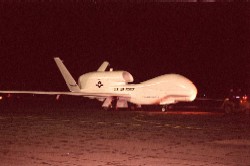
While in Australia, the Global Hawk air vehicle number five will fly about 12 missions around Australia and its maritime approaches allowing Australia's Defence Science and Technology Organisation (DSTO), the Royal Australian Air Force (RAAF) and the U.S. to jointly assess the military utility of high altitude endurance UAVs to conduct maritime, littoral and land surveillance, and stand-off reconnaissance operations.
This collaboration between Australia and the United States benefits both countries. It allows Australian scientists to contribute to leading edge UAV technology while assessing the potential value of Global Hawk for the protection of Australian territory and maritime approaches.
Global Hawk's integrated sensor suite includes a Synthetic Aperture Radar (SAR) and an electro-optic suite which provides images in the infrared and visual bands. Global Hawk is jet powered, has a wing span approximately equivalent to a Boeing 737, can fly autonomously non-stop for up to 36 hours at altitudes up to 65,000ft (19.81 km), and in a 24 hour period can search an area of 40,000 square miles (103,600 km2), twice the size of Tasmania.
Another example of technological input to the program by Australia is a ground station, known as the Australian Ground Element (AGE), which was developed by DSTO and industry for Australia's Defence Joint Project 129. The AGE will integrate with Global Hawk to provide the capability to analyse sensor data in real time/near real time for the Australian operations.
The aircraft deployed to Australia, Global Hawk air vehicle number 5, first flew in August last year and has since flown 120 hours in twelve test missions. A complete Global Hawk system has been brought to Australia consisting of the air vehicle, a ground station for controlling the aircraft, monitoring its status and making operational changes if necessary, and the sophisticated communications equipment required to command and control the air vehicle. An assessment team from the USAF's Air Force Test and Evaluation Center (AFOTEC), Kirtland Air Force Base, New Mexico, has also deployed to work with Australian personnel on the joint military utility evaluation.
Bush Delays Decision To Supply Aegis System To Taiwan
Despite authorising a package of arms sales to Taiwan that is the largest since his father allowed the sale of F-16s in 1992, President George W Bush stopped short of including sophisticated Aegis equipped destroyers that had been requested by the Taipei authorities. The four destroyers of this class were originally built for the Shah of Iran. The U.S. Navy aquired them following the Shah's overthrow in the 1970s. Four Kidd class destroyers, presently mothballed, will be supplied by 2003 instead.
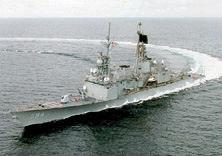
China, which considers Taiwan to be a breakaway province, had objected furiously to any such sale, saying it breached a Sino-American agreement that allowed only the sale of defensive equipment to the island.
However President Bush has only put on hold the decision to supply the Aegis system, which can track and engage hundreds of air and sea targets, according to US officials. They point out that the system is probably too sophisticated for the Taiwanese to use yet, but hinted that steps would be taken to ensure that, if, in the future the US decided to go ahead, suitable ships would be quickly available.
Bush's decision is part of the delicate diplomatic manoeuvring since the US spy plane incident, which has yet to be resolved.
The package which has been agreed includes a significant anti-submarine capability to counter the increased threat posed by China's recent acquisition of four Kilo class submarines from Russia. The US will supply 12 P-3C Orion maritime patrol aircraft and eight diesel powered submarines.
Since the US has stopped making diesel boats it is likely that submarine builders in Europe will be asked for appropriate designs, although manufacture will be in the US.
Taiwan will also get access to information on the latest Patriot anti missile missile, to counter the perceived threat posed by Chinese ballistic missiles located on the mainland opposite Taiwan.
Other equipment in the deal include submarine- and air-launched torpedoes, MH-53 minesweeping helicopters, Paladin 155 self-propelled howitzer systems and AAV7A1 Amphibious Assault Vehicles.
Boeing To Upgrade Canadian CF-18 Hornets
The government of Canada has awarded a $436 million (USD) contract to The Boeing Company for the modernization of 80 Canadian Forces CF-18 strike fighters. This upgrade will ensure that CF-18s remain combat ready and interoperable with coalition forces well into the 21st century. "This upgrade will significantly enhance the capability of the aircraft and, with a concurrent structural modification, will extend its life through 2015," said Tony Parasida, Boeing vice president for the F/A-18 program. "In addition, the planned upgrades ensure that Canadian Forces Hornets can carry Advanced Medium Range Air-to-Air Missiles and the full complement of GPS-guided air-to-ground weapon systems." Under the contract, the CF-18s will be equipped with improved communication and navigation capabilities including a new mission computer, an APG-73 radar, stores management set, a secure radio system and a Combined Interrogator/Transponder system.
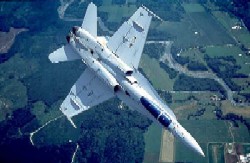
Canadian firm Bombardier Aerospace will perform installations required as part of the modernization program. Under the terms of the agreement, Bombardier will complete work at its facilities in Mirabel, Quebec. A validation and verification phase involving one A single-seat model and one B two-seat model CF-18 will begin in July 2002. Modification work on the remaining 78 aircraft is scheduled to begin in January 2003.
The Hornet upgrade program is an example of the innovative products and services Boeing offers to military services around the world to enhance mission performance and drive lower total ownership costs. Boeing is involved in many complex modernization programs, including the T-38C Avionics Upgrade Program for the U.S. Air Force, which recently entered full-rate production. The company also provides efficient supply-chain management programs that maximize aircraft readiness levels. Canada was the first international customer for the Hornet. The CF-18s operate out of Canadian Forces Base Cold Lake and Canadian Forces Base Bagotville in Canada. The F/A-18 Hornet strike fighter is in service with the air forces of seven nations, in addition to the U.S. Navy and Marine Corps. (Photo by Mike Reyno)
US Navy TCS Points Way To UAV Interoperability
The US Navy developed Tactical Control System (TCS) has conducted its first takeoff and landing of a Navy owned Predator unmanned aerial vehicle at Ft. Huachuca in Arizona recently, achieving what is known as level five flight control. cTCS is being developed as the ground control station architecture for the US Department of Defense's family of tactical UAVs, under the direction of the Programme Executive Office, Strike Weapons and Unmanned Aviation (PEO (W)). The prime contractor is Raytheon Systems Corporation, Falls Church, Virginia.
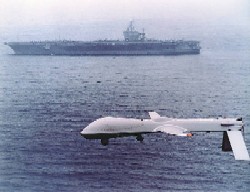
The TCS programme was formally established in September 1997 to provide command and control of all tactical and medium endurance UAVs and their payloads from a single ground station, as well as data dissemination to designated command, control, communications, computers, and intelligence (C4I) systems.
The recent Predator flight was the first formal developmental test since TCS entered engineering, manufacturing, and development (EMD) a year ago. The focus of EMD is to develop a single software product that will be used by the Navy, Army, and Air Force. The level five control indicates that TCS conducted launch and recovery, flight control, payload control, and direct data receipt from the Predator. This is the highest level of UAV control and is the most challenging to achieve.
The developmental version of TCS software used in the Predator flight is designated Block 0 version 1. This product will be provided to the US Joint Forces Command (JFCOM) located at Norfolk, Va., as a tool to support exercises and ultimately to mature joint UAV operational concepts.
Upon transfer to JFCOM, the system will be known as the UAV Joint Operational Test Bed System (JOTBS). In the vision of former Commander in Chief, US Joint Forces Command, Admiral Harold W. Gehman, Jr. JOTBS would enable JFCOM to "turn interoperability theory into reality" by experimenting with UAV interoperability concepts and tactics unconstrained by Service doctrine or policies.
The next evolution of TCS will be called Block 1, which will control the Army's Shadow 200 UAV, and Block 2 will control the Navy's Fire Scout UAV. Blocks 1 and 2 will be developed and tested concurrently. Once developmental and operational testing is complete, these products will be fielded through the appropriate service. Finally, the initial two blocks will be merged into a single software system referred to as Block 3. This consolidated product will then be fielded to all services to control Navy, Army, and Air Force vehicles with a single control system.
AF Minuteman Missiles Undergo Booster Upgrades
A new Minuteman III was installed recently at launch facility Hotel-02 in Malmstrom's missile complex. The new system was a result of the Propulsion Replacement Program which provides replacements for all three of the solid propellant booster stages that make up the Minuteman III.
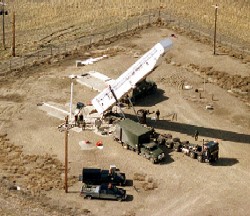
Malmstrom is home to America's "Ace in the Hole." That is what President John F. Kennedy told Soviet Union Premier Nikita Krushchev and the entire world during the Cuban Missile Crisis.
That same week, on Oct. 26, 1962, the first Minuteman missile went on alert here at launch facility Alpha-06. Nearly 40 years later, Air Force acquisition programs keep the missiles current, playing a vital role in the modernization of the Minuteman III, an upgraded version of the original weapon system.
The Minuteman III solid rocket boosters were first deployed in the early 1970s, and the missiles have received new propellant several times since then.
During the late 1980s and early 1990s, new propellant was poured into stages two and three of the weapon system, according to Maj. Todd Johnston, PRP acquisition manager. However, this is the first time propellant was replaced in all three stages at the same time.
"As the solid propellant ages (inside the boosters), it dries out and shrinks," said Col. Jack Anderson, 341st Logistics Group commander. "Eventually it pulls away from the liner of the booster and leaves air spaces or gaps. It can also crack as it dries and cause even more gaps. All of these gaps impact the way the fuel burns and can substantially reduce the efficiency and reliability of the burn."
"What makes the Propulsion Replacement Program unique is that we are taking hardware that is over 30 years old and extending the life of that weapons system," Johnston said. "It's a good deal for the warfighter and a good deal for the taxpayer."
The acquisition cost of this program is approximately $1.8 billion for 607 boosters. The program will last through 2008, and the installment of these new stages is part of the Air Force's overall effort to extend the life of the Minuteman III weapon system beyond 2020.
Since the acquisition program began in 1994, it has undergone extensive testing. Before the boosters even arrived here, a team of Malmstrom evaluators traveled to Hill Air Force Base, Utah, to perform a final inspection on the boosters prior to their shipment. During the inspection, the Malmstrom team discussed with depot engineers all the changes to the boosters and ensured those improvements matched the procedural changes to the technical data. This trip by the evaluators helped ensure a seamless transition from the old to the new boosters.
Staff Sgt. Aaron Wilson, 341st Logistics Support Squadron missile handling quality assurance evaluator, was impressed with the refurbished weapon system, and the inspection team did not find any deficiencies in the boosters.
"The many years spent perfecting the refurbishment process really showed --it looked brand new," Wilson said.
"Sustainment is an on-going requirement to keep our weapon systems operating safely, securely and effectively throughout their life," Anderson said. "Many systems prove they are capable of lasting much longer than originally planned."
"Keep in mind that to sustain the Minuteman III fleet, you have to also sustain all of the associated support hardware, facilities, equipment and vehicles. There will be sustainment programs as long as Minuteman III is on alert," he said.
Malmstrom is the first unit to receive the new boosters. The other Minuteman units, F.E. Warren AFB, Wyo. and Minot AFB, N.D., begin receiving their new boosters later this year. (Photo by Staff Sgt. John Turner)
Monday, April 23, 2001
PC News
COMBATSIM.COM Launches New Look
As of Monday, April 23rd, we introduced our latest site layout upgrade. This latest upgrade is unlike past upgrades in that we didn't do every page on the site in one fell swoop. This upgrade starts with the main page of the site and will then expand, over time, to the other areas of the site. Let us know what you think.
Flanker Beta 4 V.251 Released
SSI has released the Beta 4 of V2.51. The file is a about 1.5 MB in size and is now available for downloading. THIS BETA 4 IS BEING CONSIDERED AS THE FINAL BETA AND A LIKELY CANDIDATE FOR THE RELEASE VERSION OF 2.51. Please remember that this is a Beta and may have problems. SSI asks for your help with verification the the areas mentioned in the Read Me file (see below) are indeed addressed properly in this patch. Please assist SSI by reporting any problems you encounter with V2.51 Beta 4 and verification that previous problems have or have not. POST RESULTS HERE
Link to download V2.51 Beta 4
Since you need Beta 2 and Beta 3 for Beta 4 to work properly (you also need to start with V2.5) here is the links for V2.51 Beta 2 and V2.51 Beta 3
Make sure you unzip the file to your Flanker 2.0 directory and ensure that you unzip with the directory structure intact.
Flanker V2.51 Beta 4 Read Me File
New in Beta 4 patch
Installation instructions
CH Products USB Pro Throttle Update
The highly anticipated USB Pro Throttle is steadily making progress! Software is in it final stages of developement, and CH Products should have a beta version ready before summer. In the interim, CH Products has been working on a low end USB controller, for those of you who require a USB connection, but don't want to break the bank to own one. The Flightstick Pro USB® brings a classic joystick back to life. Utilizing the newest technology, this ambidextrous joystick offers 3 axes of control, 4 buttons, and an 8 way hat switch, and is designed after a military style F-15 handle. The Flightstick Pro USB offers excellence in comfort, design and funtionality and is a great addition to your CH setup. Click here for information on CH Products.
NVIDIA Drops GeForce Prices
In an effort to expand presence in the mainstream and retail markets, NVIDIA has added a new set of board level products and price points designed to address the high-end, midrange and value retail market segments. This new strategy includes a family of desktop products ranging from $99 to $399, re-setting the industry benchmark for combined price, performance, and value in the retail market.
NVIDIA’s new lineup starts in the value segment with the 32MB GeForce2 MX 200 board at $99. The 64MB GeForce2 MX 400 at $129 and the 64MB GeForce2 Pro at $199 are geared for the mainstream and performance segments. The lineup is completed with the flagship 64MB DDR GeForce3 for as little as $399, 20% lower than the previous high end product, the GeForce2 Ultra. All prices are suggested retail prices based on U.S. dollars.
Military News
Air Force Releases Cause Of F-15 Accident
Air Force investigators have determined a maintainer's error caused foreign object damage to an F-15 Eagle on Nov. 3. The incident occurred at Kadena Air Base, Japan, during an early morning routine training mission. After a normal takeoff, the pilot raised his landing gear. During landing gear retraction, the pilot heard a loud bang, which he interpreted as an afterburner blowout, and noticed he had indications Engine 2 was overheating.
The pilot safely continued his takeoff, followed proper procedures for handling the situation, and made a safe and uneventful landing at Kadena AB. After maintenance analysis, it was determined that some foreign object damage had occurred to both engines. The engines were returned to depot for analysis and repair.
After investigating the mishap, the accident investigation board president issued an opinion that the cause of the foreign object damage was that the crew chief failed to adequately finish preparing the aircraft for the scheduled mission.
Specifically, the crew chief failed to properly store a form binder and the enclosed forms as prescribed by local procedures, storing them instead on the forward nose landing gear door. The aircraft forms are paper documentation that the unit uses to record maintenance actions on the aircraft. When the pilot retracted the landing gear after takeoff, the forms that were improperly placed on the nose landing gear door were blown into the slipstream and ingested into the landing gear wells and into both engines.
Lockheed Martin's New Mk41 VLS
Lockheed Martin is developing a system that will allow the Mk41 vertical launching system, supplied by Lockheed Martin Naval Electronics & Surveillance Systems, Akron, to fire the Low-Cost Autonomous Attack System (LOCAAS) munition being developed by its Missiles and Fire Control, Dallas. The Vertical Launch Autonomous Attack System (VLAAS) is intended for ship defence and bombardment during operations in littoral regions.

LOCAAS, a guided and powered munition, has a range of more than 100 nautical miles. Original intended for aircraft delivery, it was designed to detect and destroy mobile land targets. Once released, LOCAAS acquires global positioning data, flies to a target area and then searches the target area for high-value targets. It can either acquire a target for immediate attack or loiter above the area until a suitable target is identified. LOCAAS has an inertial navigation system/global positioning system, automatic target recognition, and a programmable multimode warhead. LOCAAS can loiter over a 25 square nautical mile flight pattern at a speed of 215 knots.
VLAAS would establish an umbrella of loitering munitions to protect ships when threatened by fast-attack patrol boats. When dispersed from VLAAS, LOCAAS munitions would loiter over an area, acquire a target, and then attack it by powered flight and with guided accuracy.
The same vertical launch payload delivery system is in use as an antisubmarine warfare weapon. Aegis-class ships equipped with the Mk-41 vertical launching systems have the capability to fire Vertical Launch Antisubmarine (VLA) missiles, which deliver torpedoes at ship-standoff ranges to counter submarines..
"Extending the capabilities of the vertical launch payload delivery system by loading it with other munitions gives navies an already qualified booster system that integrates into the existing Mk-41 vertical launching system. Our engineers have demonstrated the compatibility of this vertical launch and LOCAAS combination to the in-place launching hardware and fire control systems," said Chuck Carlise, director-business development tactical systems at Lockheed Martin Naval Electronics & Surveillance Systems in Akron, Ohio.
Lockheed Martin Fires First Army TACMS Unitary Missile
Lockheed Martin Missiles and Fire Control - Dallas successfully conducted the first flight test of an Army Tactical Missile System (Army TACMS) Block IA Unitary Missile. The test was conducted on Saturday, April 21, at White Sands Missile Range, N.M. Preliminary data suggest that all test objectives were achieved.
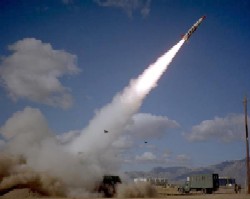
The Army TACMS Block IA Unitary is a U.S. Army initiative developed as a result of Kosovo lessons learned. Lockheed Martin was awarded the contract to develop the Army TACMS Unitary missile in December 2000. The initiative was established as a Quick Reaction Program to rapidly deploy a tactical capability for the U.S. Army. The government furnished a proven unitary warhead (SLAM/HARPOON WAU-23/B), and Lockheed Martin integrated it into an existing Army TACMS Block IA missile.
Delivery of the first missile for flight test took place just four months after contract award. A total of 42 tactical missiles are scheduled to be produced and delivered to the Army by the end of calendar year 2001.
"This is a very important step for both the Army and Lockheed Martin," said Ron Abbott, vice president - Fire Support at Lockheed Martin Missiles and Fire Control. "This test clearly demonstrates the versatility and agility of the Army TACMS design. The ability to deliver this class of warhead out to 300 kilometers with GPS accuracy opens-up a wide variety of land attack missions for Army TACMS."
Army TACMS was the first tactical surface-to-surface missile ever fired in combat by the U.S. Army, when it was deployed in Operation Desert Storm. The Army TACMS Block IA Unitary Missile is the latest addition to the current Army TACMS Family of Munitions. The Army TACMS Block IA Unitary Missile is an all weather day/night rapid response missile that provides the Army the capability to attack high-payoff, time sensitive targets with limited collateral damage.
Click Here for Printer Version
© 1997 2000 COMBATSIM.COM, Inc. All Rights Reserved.
